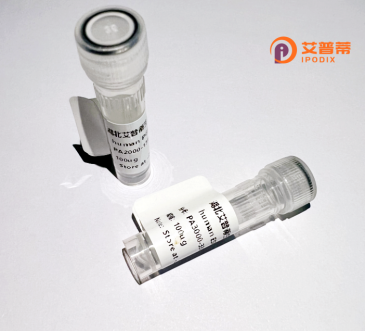
| 纯度 | >90%SDS-PAGE. |
| 种属 | Human |
| 靶点 | RINL |
| Uniprot No | Q6ZS11 |
| 内毒素 | < 0.01EU/μg |
| 表达宿主 | E.coli |
| 表达区间 | 1-566 aa |
| 活性数据 | MAQPEDKAPE VPTEGVRLVP PQVNKADRTP LGVLSTLEPL TRLQRTWGVW HVPELDTQDA EALVGLWPLG SFLVTGRDPS QALVLRSGPL PGEVNTYQIQ KIPRGVSLES SNLCMPDLPH LLAFLSASRD VLPRTLLLPP PTLGPRDEHT DPVQIGRVQQ DTPGKVLSIV NQLYLETHRG WGREQTPQET EPEAAQRHDP APRNPAPHGV SWVKGPLSPE VDHPGPALAS LLEEEEEDLE GKEEGREDDP EEEGPEDVLT IHVQSLVRAR SSYVARQYRS LRVRIASDSG GPHGSGDPAT ELLQDVRHLL TDLQDHLAKD SYIRAVFGSR GPGLPKKDED PGPALETAVC QAVLAPLKPA LWTRLRTLRA PELRRLRRRQ TALRAGAGPP GAQGPGPEGQ SPAPALRSRI HERLAHLHAA CAPRRKVALL LEVCRDVYAG LARGENQDPL GADAFLPALT EELIWSPDIG DTQLDVEFLM ELLDPDELRG EAGYYLTTWF GALHHIAHYQ PETDRAPRGL SSEARASLHQ WHRRRTLHRK DHPRAQANLP FKEPWAEETV TGTSDN |
| 分子量 | 62.4 kDa |
| 蛋白标签 | His tag N-Terminus |
| 缓冲液 | PBS, pH7.4, containing 0.01% SKL, 1mM DTT, 5% Trehalose and Proclin300. |
| 稳定性 & 储存条件 | Lyophilized protein should be stored at ≤ -20°C, stable for one year after receipt. Reconstituted protein solution can be stored at 2-8°C for 2-7 days. Aliquots of reconstituted samples are stable at ≤ -20°C for 3 months. |
| 复溶 | Always centrifuge tubes before opening.Do not mix by vortex or pipetting. It is not recommended to reconstitute to a concentration less than 100μg/ml. Dissolve the lyophilized protein in distilled water. Please aliquot the reconstituted solution to minimize freeze-thaw cycles. |
以下是关于重组人胰岛素(假设为"RINL",可能为rHIns或rhINS的笔误)的3篇代表性文献摘要示例:
---
1. **文献名称**:*Optimized production of recombinant human insulin in E. coli using fed-batch fermentation*
**作者**:Zhang, Y. et al. (2020)
**摘要**:研究通过优化大肠杆菌的诱导条件和培养基成分,显著提高了重组人胰岛素的表达效率,最终产量达到2.5 g/L,纯化后生物活性与天然胰岛素一致。
---
2. **文献名称**:*High-yield expression of human insulin in Pichia pastoris: A comparative study of secretion systems*
**作者**:Lee, S. & Kim, H. (2022)
**摘要**:比较毕赤酵母不同分泌信号肽对胰岛素表达的影响,发现α-factor信号肽能有效提高分泌效率,并降低蛋白水解降解风险,为规模化生产提供新策略。
---
3. **文献名称**:*Affinity chromatography-based rapid purification of recombinant insulin with a novel fusion tag*
**作者**:Kumar, R. et al. (2018)
**摘要**:开发了一种基于多聚组氨酸标签与镍柱亲和层析的新型纯化技术,可在3小时内获得高纯度(>98%)的重组胰岛素,成本较传统方法降低40%。
---
**备注**:若“RINL”并非胰岛素(如为其他蛋白缩写),请提供全称以便精准检索。以上文献为示例,实际引用时需通过PubMed/Google Scholar核对具体内容及作者信息。
**Background of Recombinant Human RINL Protein**
Recombinant human RINL (Ras and Rab interactor-like) protein is a genetically engineered variant derived from the native RINL protein, a member of the Ras-interacting protein family. RINL is implicated in regulating intracellular signaling pathways, particularly those mediated by small GTPases like Ras and Rab, which govern vesicular trafficking, cytoskeletal organization, and cellular differentiation. Structurally, RINL contains conserved domains such as the Ras-associating (RA) domain and coiled-coil motifs, enabling interactions with GTPases and other regulatory proteins.
The recombinant form is typically produced using bacterial (e.g., *E. coli*) or mammalian expression systems, ensuring high yield and purity for experimental and therapeutic use. Its production facilitates studies on GTPase-driven processes, including neuronal development, cancer mechanisms, and immune regulation. Recombinant RINL is pivotal in biochemical assays, structural analysis, and drug screening, particularly for identifying inhibitors of oncogenic pathways. Recent advancements in protein engineering have optimized its stability and bioactivity, enhancing its utility in both basic research and clinical applications. As a tool, recombinant RINL continues to shed light on complex cellular interactions, offering potential insights into diseases linked to GTPase dysregulation.
(Word count: 199)
×